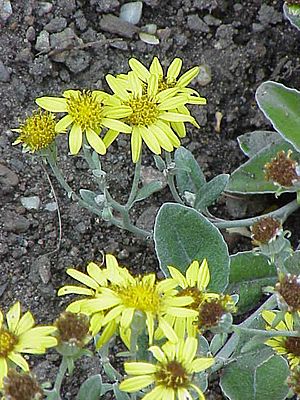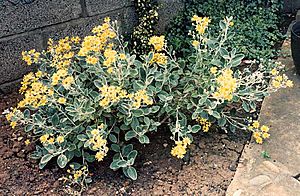Daisy bush facts for kids
Quick facts for kids Daisy bush |
|
|---|---|
 |
|
| Daisy bush | |
| Scientific classification | |
| Kingdom: | |
| (unranked): | |
| (unranked): | |
| (unranked): | |
| Order: | |
| Family: | |
| Tribe: |
Senecioneae
|
| Genus: |
Brachyglottis
|
| Species: |
B. greyi
|
| Binomial name | |
| Brachyglottis greyi (Hook. f.) B. Nord.
|
|
| Synonyms | |
|
Senecio greyi Hook.f. |
|
The daisy bush (scientific name: Brachyglottis greyi) is a cool plant from New Zealand. It's part of a big plant family called Asteraceae, which includes many daisy-like flowers. Depending on which plant expert you ask, it might be called Brachyglottis or Senecio. This plant is special because it's endemic to New Zealand, meaning it grows naturally only there. Gardeners around the world are starting to love it!
Contents
About the Daisy Bush
The daisy bush is an evergreen shrub, which means its leaves stay green all year. It's often seen in gardens, especially in places with warm weather and near the sea. It can handle lots of sun, poor soil, strong winds, and salty coastal air.
This plant grows into a sprawling bush, usually about 1.2 to 1.5 meters (4 to 5 feet) tall. It can spread out to be about 1.8 meters (6 feet) wide.
Stems and Leaves
The stems of the daisy bush are a bit curved and covered in soft, white fuzz.
Its leaves grow one after another along the stem. They are simple, meaning they aren't divided into smaller leaflets. Each leaf is shaped like an oval, about 4 to 8 centimeters (1.5 to 3 inches) long and 2.5 to 4 centimeters (1 to 1.5 inches) wide. The edges of the leaves are slightly wavy. The top side of the leaves is green, but the underside has white fuzz, which makes the whole plant look silver-grey.
Flowers
When it blooms, the daisy bush produces lots of bright yellow daisy-like flowers. These flowers grow in clusters called panicles, making a beautiful display.
Growing Daisy Bushes
The daisy bush is a popular choice for gardens because it's tough and looks great.
Cool Hybrids
Some special types of daisy bushes are called "hybrids." A hybrid plant is created when two different kinds of plants are crossed. In New Zealand, there are hybrids made from Brachyglottis greyi and other similar plants like Brachyglottis laxifolia and Brachyglottis compacta. Sometimes, people mistakenly call these hybrids Senecio greyi.
These hybrid plants are strong and do well in warm, dry places. They are especially good for coastal areas, just like their parent plants. They grow into sprawling bushes with very attractive leaves. Their leaves often have a greyish color, and the undersides of the leaves and stems are covered in white fuzz. When they bloom, they have amazing branching clusters of bright yellow daisy-flowers.
One of the most famous hybrids is called "Sunshine," which also came from New Zealand.
Another interesting hybrid is "Moria Read." This one is a variation of "Sunshine." Its leaves have cool patches of cream and pale green in the middle. This special plant first appeared in Liskeard, Cornwall, a town in England.
Where Does It Grow?
The daisy bush mostly grows along the coast, often on rocky cliffs and bluffs. However, you might also find it further inland, especially along river gorges and in other exposed, rocky areas.
Home Sweet Home
You can find the daisy bush in the southern part of the North Island of New Zealand. It grows from near a place called Flat Point all the way south to the mouth of the Orongorongo River.


